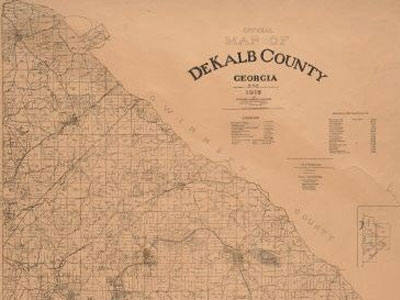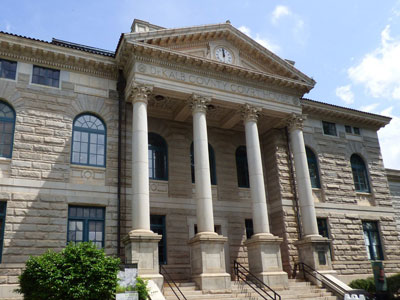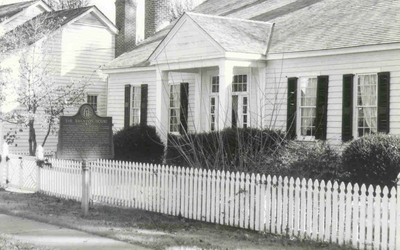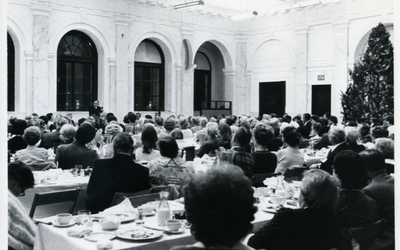EXHIBITS & HISTORY
Historic DeKalb Courthouse
DeKalb County Georgia’s first courthouse was located in Decatur, as the seat of government; built in 1823 it was described as a “crude wooden structure.”
The next courthouse was built in 1829, and was located in the center of the square. On January 9, 1842, the building caught fire in the middle of the night, destroying nearly all the county’s records. Though the cause of the fire remains a mystery, many believe it was intentionally started by careless card players.
In 1847, a new brick courthouse was constructed. It was a plain two-story red-brick building in the Greek Revival style, and had a temple front configuration supported by massive square columns. The rectangular plan featured a double staircase on the exterior and the roof was topped with a clock tower. Although the courthouse survived the “Battle of Decatur” on July 22, 1864, it was demolished in 1898 to make room for a new courthouse.
In 1898, a Neoclassical style courthouse replaced the modest brick building. Made from granite, the new structure had many new amenities, including a special room for ladies, complete with toilets. Images from the early 1900s show how rural the courthouse was – it is in the middle of a wide grassy lawn, atop one of the area’s highest points, and you cannot yet see any stores or businesses. In 1908, a Confederate monument was erected in front of the building.
At 5:20 a.m. in September 1916, firefighters were once again called to save the county courthouse. Although the interior of the building was destroyed, fireproof safes protected most of the county’s records. The thick Lithonia granite walls withstood the flames, and they provide the foundation for the courthouse that is now the home of the DeKalb History Center. The cause of the fire is thought to be a smoldering cigar butt dropped by a crowd member waiting for election results the previous night.
After the fire, the county retained what they could from the exterior of the building. The cupola was not rebuilt after the fire, but the two historic clocks were placed in the remaining porticoes. Completed in 1918, the new courthouse featured an addition of two new wings and an interior clad with Alabama marble.
This courthouse was used by DeKalb County until 1967. The judges’ chambers and rooms for the jury and grand jury were located on the second floor, while the District Attorney’s office was on the main floor. In 1967, the county built a new courthouse and the Superior Court and the District Attorney’s offices were moved into the new building.
Soon after the new courthouse was constructed, the Decatur mayor stated that the old courthouse was obsolete and should be demolished. Merchants agreed, claiming that the location of the new courthouse aggravated parking problems and deterred shoppers from frequenting their stores. Others believed that driving around the square was an inconvenience. By way of rebuttal, Scott Candler stated, “That Square is the heart of the city and the county. Why, the whole history of DeKalb is tied up in that building. People who advocate tearing it down have no love for the county, no sentiment.” Other locals called for the preservation of the old courthouse, recommending turning the building into a museum and archives so that it could be saved and used. After public uproar and debate, the demolition idea was set aside.
In the aftermath of the debate, the DeKalb County Commissioners saw fit to grant space in the building to the group which kept local history: the DeKalb Historical Society (DHS). In 1968, we moved into our present headquarters from a small space in the Decatur library. Our archives and library opened to the public on a daily basis in 1977 and the museum first opened in 1983.
This DeKalb County Courthouse was listed on the National Register of Historic Places in 1971 and honored by Governor Jimmy Carter through a State of Georgia Proclamation. It was the third National Register listing in the Metropolitan Atlanta area.
Major repairs and renovations were undertaken in 1975 to prepare the Courthouse for the Bicentennial. Occasional restoration projects were completed over the years, but the plans rapidly moved forward when the DHS organized a fund raising campaign in 1989.
The construction of the Decatur MARTA (Metropolitan Atlanta Rapid Transit Authority) Station led to major changes around the Courthouse beginning in 1976. In March of that year, a row of elm trees that were parallel with the Confederate Memorial were removed to make way for construction. Because of this project, Atlanta Avenue and Sycamore Street were closed behind the Courthouse, and it is no longer located in a “square.”





